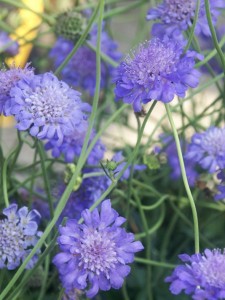When I first wrote about pincushion flowers, which go by the unattractive Latin name, scabiosa, fifteen years ago, I had just purchased a lovely one. It was a striking dark purple-flowered variety, ‘Ace of Spades’. Billed as a perennial, I cosseted the plant for its entire first year, giving it sun, water and a prime garden position. It rewarded me with lots of flowers.
And it died over the winter.
When I rechecked the zone hardiness information, I realized that it really wasn’t cold weather tolerant. We live and learn.
After that, I consoled myself with other things, including a lot of roses, but something kept me from trying pincushion flowers again. The pincushion drought finally ended a few weeks ago when I treated myself to three plants of the classic Scabiosa columbaria ‘Butterfly Blue’. This time I checked the hardiness. Just to be on the safe side, the plants will be mulched to the hilt in late fall.
Scabiosa, a member of the Caprifoliaceae or honeysuckle family, has been in cultivation for centuries. Scabiosa altropurpurea, an ancestor of many modern hybrids and varieties, made its way from its native Italy to England in 1620. Despite its popularity, scabiosa has never managed to lose its unfortunate genus name, which comes from the Latin word for “itch”. Apparently before the invention of modern-day itch creams, people made decoctions from the leaves to treat the many itchy rashes that afflicted the frequently-unwashed population. Linnaeus, inspired by that idea, attached the itchy genus name to an attractive group of plants.
Most garden scabiosa start out with a mound of elongated basal leaves, which is sometimes gray-green in color. When the flowering stems appear in late spring or early summer, they generally grow to a height of 18 to 24 inches, with a branching habit. Those stems are adorned with rounded flowerheads made up of tightly packed, spherical centers of tiny petals and stamens surrounded by halo of longer petals. The “pincushion” nickname came from the fact that the stamens protruding from the tight, rounded “cushion”, look like tiny pins. Pincushion flowers come in a range of shades from cream, yellow and pink, through a host of blues, blue-purples, and purples that are near black.
Pincushion flowers start blooming in June and continue pushing out blooms throughout the growing season. Those flowers are a great draw for butterflies, but are not among the preferred treats for Mr. Antlers and his deer family. They also make long-lasting cut flowers.
Now that I have ‘Butterfly Blue’, with its soft blue pincushions, I can take stock of the many cultivated varieties and hybrids that have come to market since my brief fling with ‘Ace of Spades’.
Blue and blue-purple-flowered varieties abound, most notably ‘Fama’, which tops out at 24-inches and bears large, three to four-inch flowers. The lovely-sounding ‘Mariposa’ features a frilly, light blue-purple center, accented with white “pins”. The surrounding double petal halo is a shade or two darker. ‘Mariposa’ is a little shorter than some other scabiosa, growing 15 to 18-inches tall. ‘Giant Blue’, a hybrid, is much like ‘Butterfly Blue’ but with slightly shorter stems, a more vigorous growth habit and larger flowers. For pots and border fronts, try little ‘Blue Diamonds’, a mighty-mite of a plant that grows only six inches tall. The only caveat about ‘Blue Diamonds’ and its equally small sibling, ‘Pink Diamonds’, is that they are less hardy than other scabiosas and only work in USDA Zones 7 and higher.
Purple pincushions include my lamented ‘Ace of Spades’ and ‘Beaujolais Bonnets’, a cold-hardy variety that grows to 24-inches tall and sports burgundy pincushions surrounded by lighter purple petals. ‘Vivid Violet’ is medium purple with a hint of blue and grows to 18 inches, with gray-green foliage.
Lovers of pink can choose from ‘Pink Mist’, a sibling of ‘Butterfly Blue’ with similar traits, or ‘Pink Lemonade’, the only scabiosa I know of with variegated foliage to add interest when not in bloom. ‘Fata Morgana’ is a yellow variety, blushed with pink. For more cream- yellow try Scabiosa ochroleuca, which grows tall—to 36 inches—and blooms in a shade the catalog vendors call “soft primrose”.
All pincushion flowers like a sunny location and dislike wet feet. This makes them drought tolerant, which is a good thing, but fussy about overwatering, which may be problematic for gardeners who think the hose or irrigation system is the answer to every horticultural prayer. If your soil is heavy clay, amend it with plenty of organic material when planting your pincushions.
At this time of year, the fastest route to pincushion flowers is your local well-stocked garden center or nursery. Barring that, you can order from the good selection at Bluestone Perennials, www.bluestone.com, or Forest Farm, www.forestfarm.com. An internet search will also yield suppliers for less common species and varieties.
Sometimes it takes a long time to get over the death of a promising plant like ‘Ace of Spades’. Fifteen years seems a little excessive. Perhaps I’ll compensate by installing a crowd of pincushions in my beds and borders now.
